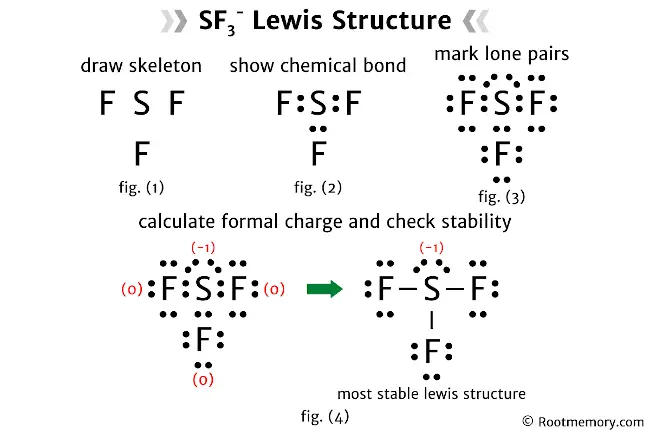
The Lewis structure of SF3– contains three single bonds, with sulfur in the center, and three fluorines on either side. There are three lone pairs on each fluorine atom, and two lone pairs on the sulfur atom.
Plus, there is a negative (-1) charge on the sulfur atom.
Alternative method: SF3– Lewis structure
Steps
Draw skeleton
In this step, first calculate the total number of valence electrons. And then, decide the central atom.
- Let’s calculate the total number of valence electrons
We know that… sulfur is a group 16 element and fluorine is a group 17 element. Hence, sulfur has six valence electrons and fluorine has seven valence electrons.
Now SF3– has one sulfur atom and three fluorine atoms.
So the total number of valence electrons = valence electrons of sulfur atom + (valence electrons of fluorine atom × 3)
And SF3– has a negative (-1) charge, so we have to add one more electron.
Therefore, the total number of valence electrons = 6 + 21 + 1 = 28
- Now decide the central atom
The atom with the least electronegative value is placed at the center. By looking at the periodic table, we get the electronegativity values for sulfur and fluorine as follows:
Electronegativity value of sulfur = 2.58
Electronegativity value of fluorine = 3.98
Obviously, sulfur is less electronegative than fluorine. Hence, assume that sulfur is the central atom.
So now, put sulfur in the center and fluorines on either side. And draw the rough skeleton structure for the Lewis structure of SF3– something like this:

Also read: How to draw Lewis structure of CH3CN (5 steps)
Show chemical bond
Place two electrons between the atoms to show a chemical bond. Since sulfur is surrounded by three fluorines, use six electrons to show three chemical bonds as follows:

Also read: How to draw Lewis structure of NOF (5 steps)
Mark lone pairs
As calculated earlier, we have a total of 28 valence electrons. And in the above structure, we have already used six valence electrons. Hence, twenty-two valence electrons are remaining.
Two valence electrons represent one lone pair. So twenty-two valence electrons = eleven lone pairs.
Note that sulfur is a period 3 element, so it can keep more than 8 electrons in its last shell. And fluorine is a period 2 element, so it can not keep more than 8 electrons in its last shell.
Also, make sure that you start marking these lone pairs on outside atoms first. And then, on the central atom.
The outside atoms are fluorines, so each fluorine will get three lone pairs. And the central atom (sulfur) will get two lone pairs.
So the Lewis structure of SF3– looks something like this:

In the above structure, you can see that the octet is completed on the central atom (sulfur), and also on the outside atoms. Therefore, the octet rule is satisfied.
After completing the octet, one last thing we need to do is, calculate the formal charge and check the stability of the above structure.
Also read: How to draw Lewis structure of HCOOH (5 steps)
Calculate formal charge and check stability
The following formula is used to calculate the formal charges on atoms:
Formal charge = valence electrons – nonbonding electrons – ½ bonding electrons
Collect the data from the above structure and then, write it down below as follows:
- For sulfur atom
Valence electrons = 6
Nonbonding electrons = 4
Bonding electrons = 6
Formal charge = 6 – 4 – ½ (6) = -1
- For each fluorine atom
Valence electrons = 7
Nonbonding electrons = 6
Bonding electrons = 2
Formal charge = 7 – 6 – ½ (2) = 0
Mention the formal charges of atoms on the structure. So the Lewis structure of SF3– looks something like this:

In the above structure, you can see that the formal charges of atoms are closer to zero. Therefore, this is the most stable Lewis structure of SF3–.
And each horizontal line drawn in the above structure represents a pair of bonding valence electrons.
Now SF3– is an ion having a negative (-1) charge, so draw brackets around the above Lewis structure and mention that charge on the top right corner. And then, the Lewis structure of SF3– looks something like this:

Next: Lewis structure of CH3CN
Related
- Lewis structure of CH3CN
- Lewis structure of NOF
- Lewis structure of HCOOH
- Lewis structure of H2CO3
- Lewis structure of CH3OCH3
External video
- How to Draw the Lewis Dot Structure for SF3 – – YouTube • Wayne Breslyn
External links
- SF3- Lewis Structure in 5 Steps (With Images) – Pediabay
- Lewis Dot Structure for SF3: Step-by-Step Guide – Eightify
- Draw the lewis structure for SF3-, and indicate how many electron groups are around the central sulfur atom in SF3-, and What is electron geometry and molecular geometry? – Chegg
Deep
Rootmemory.com was founded by Deep Rana, who is a mechanical engineer by profession and a blogger by passion. He has a good conceptual knowledge on different educational topics and he provides the same on this website. He loves to learn something new everyday and believes that the best utilization of free time is developing a new skill.
